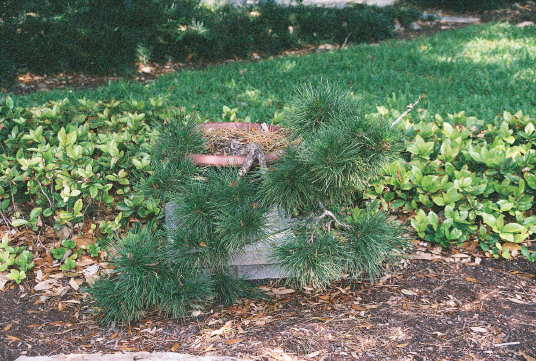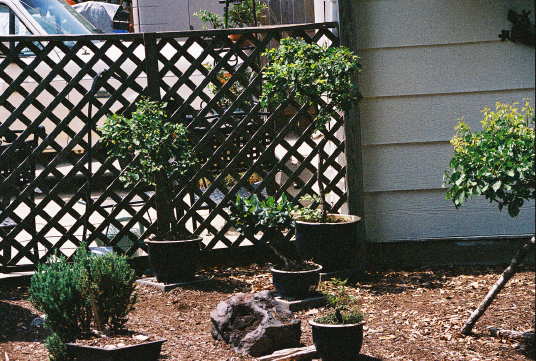
I had killed several bonsai of different tree species over a ten year period before that. My next oldest tree is from 1985, a local Texas species, cedar elm. While I don’t have a photo of it on hand, in the background of the photo below are two very large cedar elms, both from 1995.

I have killed some 400 bonsais (or more, certainly not less) over the years, and will likely lose two or three this year. It is one thing to lose a year old tree, quite another to lose a tree you have nurtured for 20 years.
The basis or formula for bonsai soil mixes are focused primarily on the promotion of suitable drainage within the soils to and out of the pot’s drain holes. Japanese bonsai and Chinese pinjing pots aid in the process by providing two or more large drain holes in their bottoms. A large pot will have five or six large drain holes; where a “western” pot will have only one drain hole, a small one for small pots and a somewhat larger drain for bigger pots. So the very first thing you must know before you mix the soils is whether it is a well drained pot, or not. Especially if you are like me and own about 50% each of both types.
A secondary, but important factor to consider is related to the first in that it focuses on whether the species to be planted requires drier soils or tolerates wetter soils. A third, but less important factor to consider is whether the tree species to be potted requires certain special qualities in the organic portion of the mix.
To summarize, a “drier” tree species such as a black pine (a short leafed pine) should be potted in a “drier” pot (with more and larger drain holes) with a “drier” soils mix. A “medium” tolerant species such as a loblloly pine or a cedar elm should be planted with a wetter soils mix in a well-drained pot or a drier mix in a poorly-drained pot. A wetter species such as water oak or willow oak should be planted a little bit wetter, and a cypress should be planted very wet. The watering cycle for each tree then must consider each day how dry a species the tree is and how dry it is planted in relation to that, before deciding whether to water and how much.
A dry soils mix consists of about 60% drainage materials translated from Japanese as “grit” and about 40% of organics. A medium wetness soils mix would be about 50% of each and a wet mix would be about 40% grit and 60% organics. Note that there is no 100% organic mix, even for cypress trees.
Of course, Pearlite was not available for drainage when the traditional Chinese and Japanese mixes were worked out centuries ago. So, traditional mixes specify “grit” for drainage to be a well-washed gravel or a very coarse well-washed sand (to wash out the salt) if no suitable gravel is available. Granite sand is the best, it contains no salt and actually provides a mineral fertilizer benefit. But it is expensive! After spending a good part of a day sifting different grits out of a 50 lb bag; maybe 30% is usable grit and the rest is too fine to use. Some lean years I have used Pearlite myself, although not often. It’s sure cheap! The most expensive is baked clay – calcined clay – granules from Japan. Medium-grained sand or fine-grained sand like “play sand” are not to be used under any circumstances. If very coarse, washed sand is to be used, it must be no more than 50% of the total grit in a mix.
The Chinese/Japanese secret to potted tree survival is in “sifting” the grits to different sizes by shaking them through different size wire screens. It pains me to read a beginner’s “learn to raise bonsai” book with lots of pretty pictures, but very little or no description of sifting out different sizes of grits. A long time bonsai practitioner will kill many trees in his lifetime; but a person who does not start out from day one sifting bonsai soil mixes will quit in disgust the first year or two. All of the “fines” that pass through a small wire screen are disposed of elsewhere and not mixed in the soils at all. Small grits captured in a small screen are used in small pots, medium grits are used in medium pots, and large grits are used in large pots. Large grits are also utilized in the bottoms of small and medium pots to promote drainage towards the drain hole.
The organic portion can be any organic material that does not rot easily and contain a stable structure that can be sifted. An excellent organic material with those qualities is shredded bark. They have to be sifted and separated into small, medium and large sizes also before mixing with the grits. A very difficult (but necessary) organic to sift is compost. A lot of time can be spent sifting dry compost, and only have a little bit of material for the time spent. However, fruit trees and a few other species require a “rich” organic such as compost to be in the mix. It must be mixed carefully to avoid wet soil conditions.
Skip
 A page Dedicated to My Writing
A page Dedicated to My Writing
Now I will have to work on my soil sifters. Gives me a new project to build!
Bob
Well it’s that time of the year again for repotting – so I need to sift a lot myself soon, real soon…
Need to order some of that chicken grit granite sand first tho..
Skip
[…] Vote Soil Considerations for Bonsai or Killin’ Bonsais […]
Hey 🙂 Love your site, I was searching google for bonsai related sites, your articles were really helpful. Thank you!!
You’re welcome!
Skip
Update – my soil sifting has fallen to new lows since my son moved away with them several years ago. He took the bonsai screens with him and I thought maybe he would do some, and bring some to me….. But his new job has him busier than I am and no new soils are coming my way. My re-potting has fallen to new lows, and my old black pine in the photo above has died from lack of re-potting regularly. I did have enough small grit soils to repot my little cedar elm, which is now my oldest tree, and it is doing quite well.
Skip